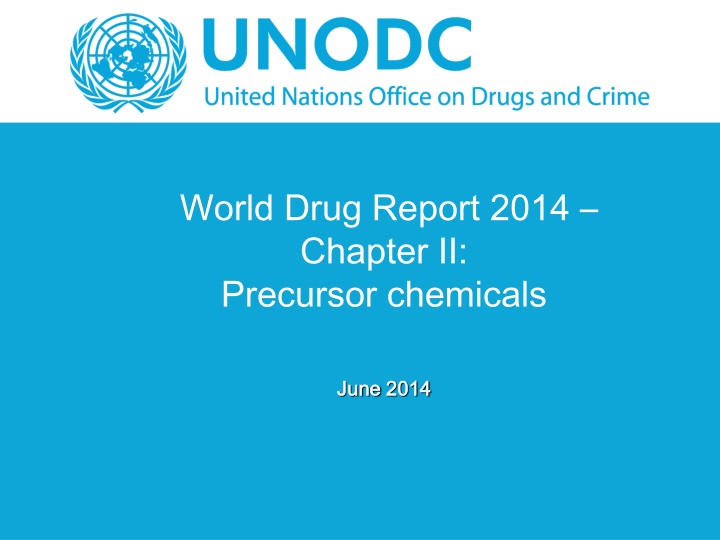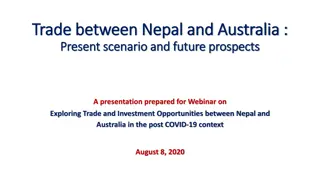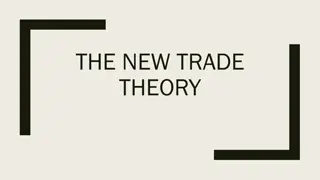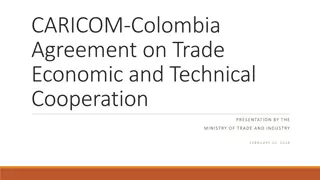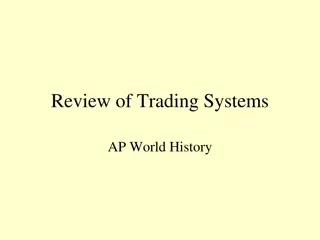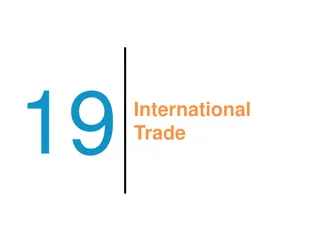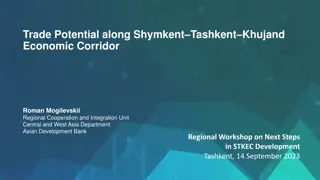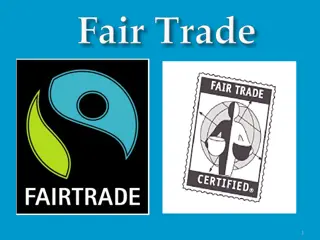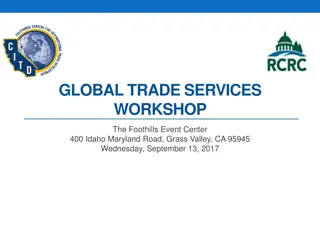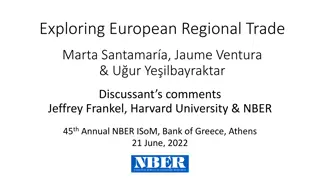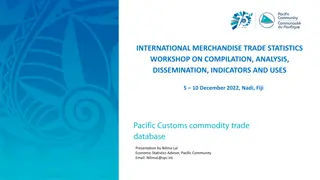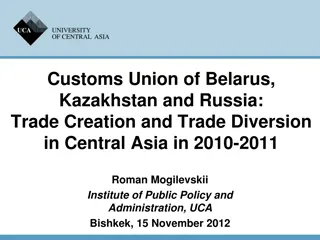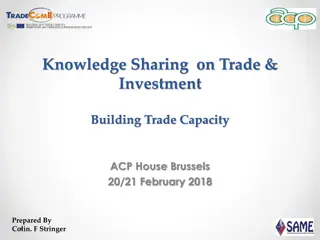Global Trade in Chemical Industry 1990-2012
Regional distribution and growth trends in exports, output, value added, and manufacture of precursor chemicals in the global chemical industry from 1990 to 2012 are analyzed. The data highlights the significant roles played by different regions, including Asia, Europe, the Americas, Africa, and Oceania, in the chemical industry's global landscape. The trade in internationally controlled precursors is also discussed, shedding light on the export-import dynamics and the key players in this sector.
Download Presentation

Please find below an Image/Link to download the presentation.
The content on the website is provided AS IS for your information and personal use only. It may not be sold, licensed, or shared on other websites without obtaining consent from the author.If you encounter any issues during the download, it is possible that the publisher has removed the file from their server.
You are allowed to download the files provided on this website for personal or commercial use, subject to the condition that they are used lawfully. All files are the property of their respective owners.
The content on the website is provided AS IS for your information and personal use only. It may not be sold, licensed, or shared on other websites without obtaining consent from the author.
E N D
Presentation Transcript
World Drug Report 2014 Chapter II: Precursor chemicals June June 2014 2014
Regional distribution of the value added of the global chemical industry, 1990-2010 50% Distribution of value-added of chemical industry 42% 37% 40% 35% 35% 32% 32% 30% 30% 27% 30% 24% 21% 19% 20% 9% 10% 7% 5% 3% 2% 2% 1% 1% 1% 1% 0% All Asia - - - All Africa Other Asia All Oceania Other Americas All Europe Other Europe East & South-East Asia West & Central Europe North America All Americas Americas Europe Asia Africa Oceania 1990 2010 Source: UNODC estimates based on World Bank, Indicators, August 2013.
Global exports of the chemical industry, 1990-2012 Growth in exports, output and value-added of the chemical industry (based on constant US$) 10.0% 2,000 8.7% in billion US dollars 8.0% Average annual growth in % 1,500 6.1% 5.8% 6.0% 1,000 4.0% 3.5% 3.3% 500 2.4% 2.0% 0 1990 1992 1994 1996 1998 2000 2002 2004 2006 2008 2010 2012 0.0% Value added Output Exports in current US dollars in constant 2012 US dollars 1990-2010 2000-2010 Sources: UNODC estimates based on World Bank Indicators, UNIDO Industrial Database and UN COMTRADE (SITC Rev.3).
Potential manufacture of precursor chemicals (Table I and Table II), 2010-2012 20 countries officially reported manufacture of Table I precursors to UNODC over the 2010-2012 period (8 in Asia, 8 in Europe and 4 in the Americas). 77 potential precursors producing countries account for 77% of the world population Sources: UNODC, Annual Reports Questionnaire data and UN COMTRADE data.
Regional distribution of trade in internationally controlled precursors Regional distribution of trade in internationally controlled precursors (Table I and Table II), 2010 (Table I and Table II), 2010- -2012 2012 Exports - Exports - Imports - Imports - 122 countries; N = $7.8 billion per year 122 countries; N = $7.8 billion per year 150 countries; N = $8.6 billion per year 150 countries; N = $8.6 billion per year Africa, 2% Africa, 2% Oceania, Oceania, 0.1% 0.1% Oceania, Oceania, 1% 1% Africa, 3% Africa, 3% Americas, Americas, 16% 16% Americas, Americas, 19% 19% Asia, 41% Asia, 41% Asia, 41% Asia, 41% Europe, Europe, 40% 40% Europe, Europe, 36% 36% Net exporting countries - 29 countries; N = $3.1 billion per year 29 countries; N = $3.1 billion per year Net exporting countries - Africa, 3% Africa, 3% Oceania, Oceania, 0% 0% Americas, Americas, 5% 5% Europe, Europe, 32% 32% Asia, 59% Asia, 59% Source: COMTRADE data.
Global (legal) exports of precursor chemicals in constant 2012 US dollars, 1996-2012 9,000.0 1,800.0 in million constant 2012 US dollars Change: 1996-2012: Table I precursors: +35% Table II precursors: 3 times 8,000.0 1,600.0 (all precursors and Table II precursors) in million constant 2012 US dollars (Table I precursors) 7,000.0 1,400.0 6,000.0 1,200.0 5,000.0 1,000.0 4,000.0 800.0 3,000.0 600.0 2,000.0 400.0 1,000.0 200.0 0.0 0.0 1996 1997 1998 1999 2000 2001 2002 2003 2004 2005 2006 2007 2008 2009 2010 2011 2012 All internationally controlled precursors (left axis) Table I precursors (right axes) Table II precursors (left axes) Source: COMTRADE data.
Global seizures of Table I precursors, 1989-2012 1,400 1,200 1,000 Seizures in tons 800 600 400 200 Cocaine precursor* Heroin precursor* ATS precursors* Others* Table I substances 3 years average (smoothed) *cocaine precursor: potassium permanganate; heroin precursor: acetic anhydride; amphetamine-type stimulants (ATS) precursors: P-2-P, phenylacetic acid, ephedrine, pseudoephedrine, norephedrine, 3,4-MDP-2-P, safrole, isosafrole, piperonal; others: lysergic acid; ergometrine, ergotamine, N-Aceylanthranilic acid *preliminary data for 2012; data may still rise once additional information becomes available. Source: INCB, 2013 Precursors report, New York 2014 (and previous years).
Effects of precursor control Seizures and stopped shipments Seizures of Table I precursors: 12-fold increase 1990-92 and 2010-2012 Stopped precursors shipments even more important than precursors seizures Additional measurements of effectiveness : Interception rate (15% for diverted potassium permanganate and acetic anhydride over the 2007-2012 period) Reduction of drug availability Seizures of precursor chemicals compared to drug seizures Seizures of ecstasy precursors: 18% more than ecstasy seizures (2007-2012); Seizures of amphetamines precursors: > 2-fold seizures of amphetamine and meth- Cases of reductions in supply of drugs linked to precursors control: LSD, methaqualone, ecstasy Impact of precursor control on prices: Licit: $1-1.5 per litre of acetic anhydride; Afghanistan: $8 in 2002; $200 ($157-$221) in 2013 amphetamine (2007-2012)
Reactions of clandestine operators More sophisticated ways to obtain precursor chemicals Creation of specialized groups to obtain the precursors chemicals Creation of front companies Identification of weak links in the control system (e.g. countries in Africa or territories such as Taiwan province of China which are not making use of pre-export notifications (PEN) and are not participating in the precursors communication incident system (PICS)) Identification of weaknesses at the national level (diversion from domestic sources) Use of the Internet Use of pharmaceutical preparations (containing ephedrine and pseudoephedrine) Use of substitute chemicals and pre-precursors (APAAN, esters of phenyl- acete (ethyl phenylacete, methyl phenylacetate), 3,4-MDP-2-P methyl glycidate, methylamine, etc.) Production of New Psychoactive Substances (NPS)
Conclusions Potential vulnerabilities of diversion of precursor chemicals increased over the last two decades Nonetheless, progress has been made in precursor control since the 1988 Convention was adopted Challenges are arising from new strategies adopted by operators of clandestine laboratories, notably the use of non-controlled substitute precursors Some of the instruments (international legal requirements) already exist: limited international special surveillance list diversion of non-scheduled substances for clandestine manufacture made a criminal offence pre-export notifications for non-scheduled substances and pharmaceutical preparations participation in the PICS, including for non-scheduled substances but are still awaiting global implementation
THANK YOU FOR YOUR ATTENTION For more information: http://www.unodc.org/
